Innovative strategies for businesses to attain Net Zero ready status

In recent years, there has been a notable rise in the global commitment to achieving net zero. However, this widespread effort needs substantial contributions from businesses to become net zero-ready.
Effectively designed and ambitious climate targets are vital in achieving global net zero by approximately 2050. This alignment is crucial to stick to the 1.5°C temperature limit set by the Paris Agreement.
However, businesses must do more than offset carbon emissions; they need a transformative shift in their operations at all scales.
For businesses, addressing climate change is also an opportunity to foster growth and attract talent, partnerships, and investment. Even by eliminating the tiniest contribution of carbon emissions through facilities or supply chains, businesses can decrease operational expenses.
The responsibility is equally crucial for small and medium-sized enterprises (SMEs), who represent around 90% of businesses on a global scale, contributing 60-70% of carbon emissions.
Role of SMEs in meeting net zero target
A constructive starting point is to develop an awareness of the current emissions balance with an examination of scope one emissions – those directly generated by the business. Even if SMEs can manage the burden of compliance, clear reporting obligations may prevent them from driving greener practices. Expect reporting, emissions reduction is required to be integrated into every essence of an organization.
Related: The rising interest in tracking Scope 4 emissions
According to Scott Kelly, senior vice president at Risilience, a climate analytics platform, a focus on sustainability should originate from the highest levels of the organizational hierarchy. Large companies often mistakenly assign these responsibilities to lower-level management, neglecting their strategic importance.
SMEs possess a crucial potential role as facilitators in promoting the broader adoption of low-carbon technologies. The range of activities within this domain is extensive. One notable example is the Belfast Maritime Consortium's high-speed, zero-emission passenger ferry (set to commence a pilot scheme in 2024), which could significantly assist numerous commuters in reducing their daily travel emissions.
Related: Is investing in carbon credits a viable solution to meet climate targets?
How are big nations and companies doing?
The Net Zero Stocktake 2023 annual report assessed the commitment of net zero targets globally (Figure 1). It included the top 25 emitting nations, states, and regions, cities with over 500,000 populations, and the world's largest 1,000 publicly-listed companies included in the Forbes Global 2000 list.
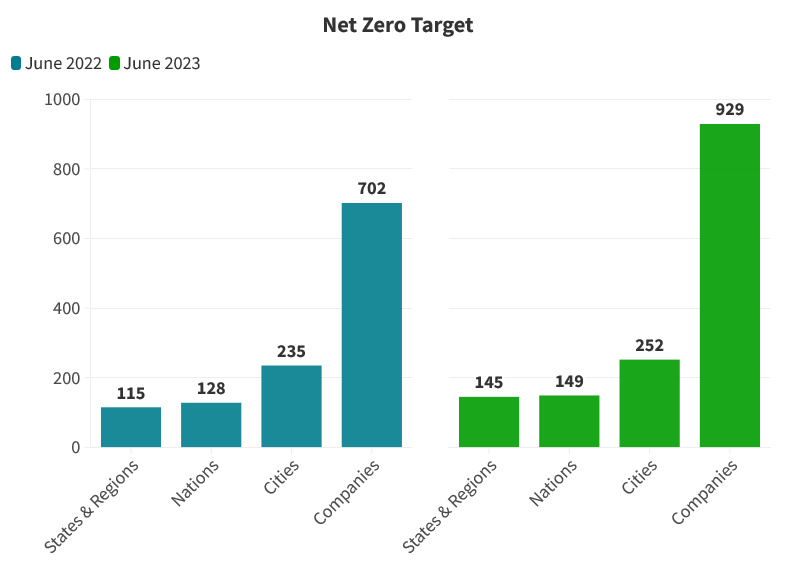
Between June 2022 and June 2023, the major publicly listed corporations with net zero targets rose from 702 to 929. The number rose by more than 40% — from 702 in June 2022 to 1,003 in October 2023.
The breakdown of net zero targets from countries in June 2023 is shown in Figure 2. About 60% of the targets are already in a policy document, about 15% are covered by law and 14% are in discussion.
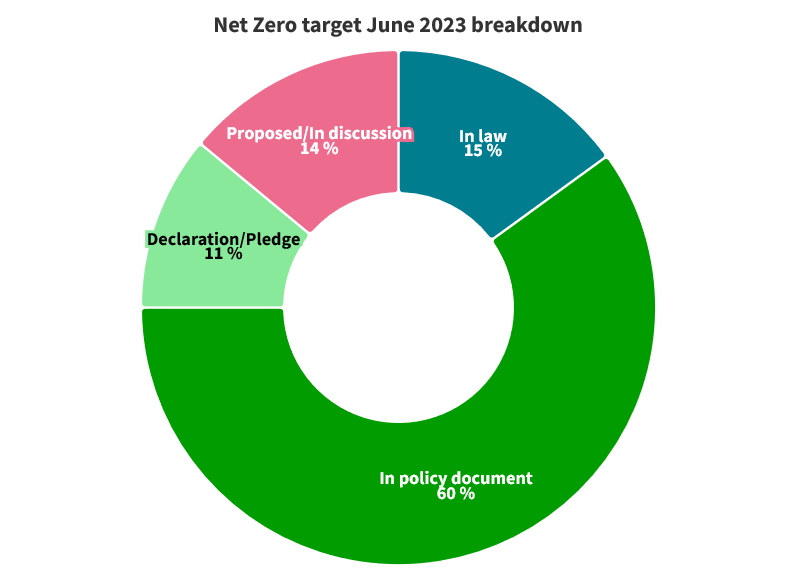
Despite this, the report suggests only about 4% of companies' net-zero commitments align with the UN Starting Line criteria. These criteria outline procedural steps for the Race to Zero, requiring specific net-zero targets, clear conditions for offset use, immediate implementation of emission-cutting measures, and regular reporting.
Furthermore, the report highlights that only 37% of corporate net-zero targets comprehensively address Scope 3 emissions— indirect emissions, such as supply chain, product distribution, customer usage, and waste disposal in organizational operations.
Its about time we become net zero ready
Sustainability is more than just a business approach; it expresses a corporate-level commitment to doing what is ethically right, driven by the transformation of their operations to contribute positively to the world. According to the November 2023 record, approximately 145 countries had either declared or were contemplating net-zero targets. This covers about 88% of global emissions and includes major contributors such as China, the EU, the USA, and India, as shown in Figure 3.
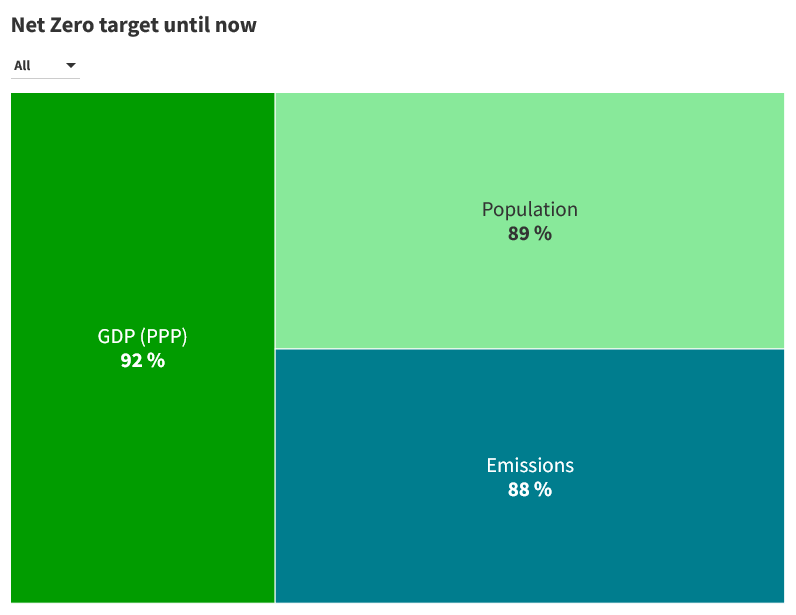
The assessment of global greenhouse gas (GHG) emissions as of October 5, 2023, is shown in Figure 4. China and the U.S., who are responsible for 28% and 14% of emissions, respectively have already pledged net zero targets but there are remaining countries responsible for 11% of the emissions yet to be pledged.
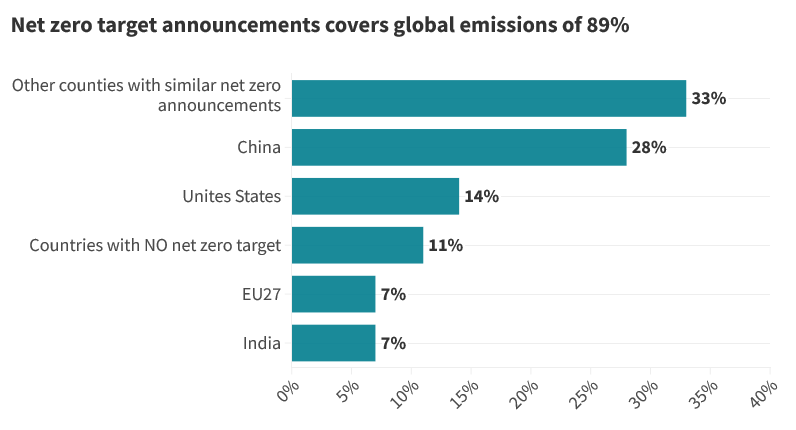
Read: Carbon Neutral vs Net Zero
Sustainability initiatives for businesses to meet net zero goals
Businesses can choose the appropriate "sustainability initiatives" that align with their unique circumstances and requirements. For example;
- Promote recycling and reusing where possible. It involves the recovery of in-process materials or by-products and avoiding the waste creation. For example, Unilever achieved zero-waste-to-landfill certification in 2016 by eliminating landfill waste across 600 sites in 70 countries.
- Establish a net-zero plan and train your staff. It prepares employees for the specific requirements and also establishes the foundation for the necessary cultural shift.
- Opt for renewable energy sources. Apart from decreasing emissions, this also positions your business to comply with potential future environmental regulations. For example, Google aims to achieve the goal of utilizing carbon-free energy 24/7 on every grid within the operational scope by 2030.
- Promote eco-friendly transportation, such as using public transport, bicycle, or electric cars.
- Reduce packaging around the building. This initiative involves restructuring business operations to minimize pollution and carbon emissions.
- Select suppliers actively reducing their emissions and opt for products with lower energy requirements in production, transportation, and use to decrease your business's supply chain emissions.
- Adopt Lean principles in various business areas. This approach minimizes waste without compromising productivity, considering factors like excess processing, overproduction, avoidable delays, and excess inventory. General Motors serves as an exemplary case of implementing Lean principles.
Apple as an Example
Apple is committed to achieving carbon neutrality throughout its entire global supply chain and the life cycle of each product by 2030. The company aims to evaluate manufacturing partners' decarbonization, with a focus on using 100% renewable electricity in their efforts. Apple's contribution to carbon footprint as of 2022 is shown in Figure 5.
As an integral aspect of Apple's engagement with its over 200 suppliers, representing more than 70% of Apple’s direct manufacturing expenditure, have already committed to utilizing clean power, such as wind or solar.
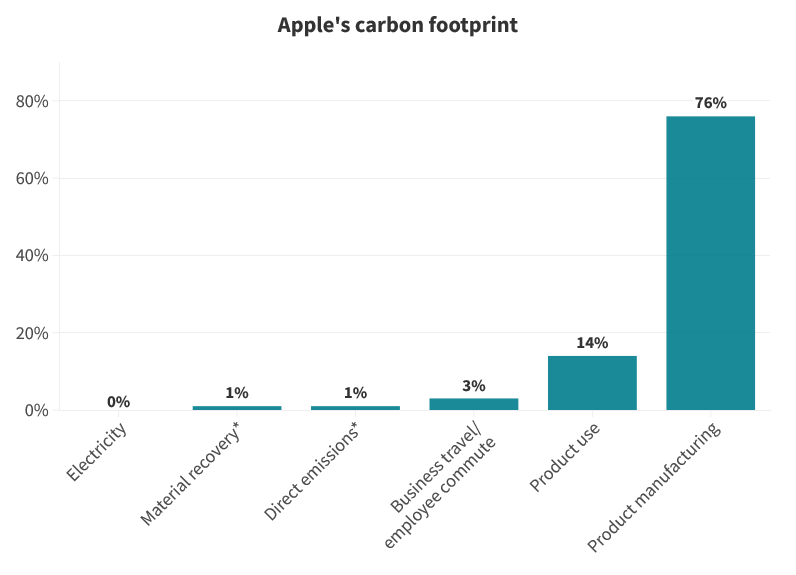
Although investments in corporate sustainable business practices should extend beyond addressing climate change alone, businesses must recognize its importance to make themselves net zero ready. If the businesses have not yet planned or invested in sustainability strategies and initiatives, they may lag behind competitors and will likely soon experience the conclusion. The Sooner the businesses determine the most suitable initiatives and sustainability strategy, the sooner they become net zero ready.



